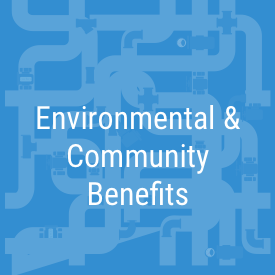At Valley Water, we are working to protect our community’s drinking water, keep residents and businesses safe from flooding and natural disasters, repair and replace aging dams, reservoirs and pipelines, while reducing toxins, hazards and contaminants in our waterways.
Anderson Reservoir is currently limited to about 3% of its capacity due to seismic concerns (see News and Updates tab below for current operating capacity), costing Santa Clara County valuable drinking water resources. This project covers earthquake retrofitting of Anderson Dam to improve reliability and safety, and returns the reservoir to its original storage capacity.








Join Valley Water at its next public meeting on May 24, 2023
Valley Water invites you to learn the latest about the Anderson project and the progress on the construction of a new outlet tunnel. The meeting will be held at the Morgan Hill Community and Cultural Center at 17000 Monterey Road. Start time is 6:30 p.m. You can also join the meeting via Zoom at https://valleywater.zoom.us/j/84388466354
The tunnel project is the first part of the federal emergency order to speed up construction of a replacement dam to fix seismic safety concerns.
Alternate recreational areas
While the Anderson Dam Tunnel Project is under construction, large portions of the Anderson Lake County Park will remain open, including the Live Oak Picnic area, the Rosendin area, the Anderson Lake Park Visitor Center and the Coyote Creek Parkway. However, some areas of the park will be closed, impacting recreational activities such as angling, boating, hiking and picnicking around the dam and reservoir. These activities will be limited or completely closed.
During construction, please check out these alternative recreational spots nearby:
- Coyote Lake Harvey Bear Ranch County Park. Located just upstream of Anderson Reservoir, the park provides power and non-power boating, fishing, hiking, picnicking, nature trails, camping and biking opportunities around Valley Water's Coyote Reservoir.
- Calero County Park. Boating, fishing, hiking and picnicking is available. The park surrounds the nearby Calero Reservoir.
- Henry Coe State Park. Located about three miles east of Anderson Reservoir, the park is the largest state park in northern California and protects and preserves 87,000 acres of scenic hills and mountain ridges in the Diablo Mountain Ridge. The largely undeveloped park welcomes backpackers, equestrians, mountain bikers, day hikers and anyone seeking solitude in a nearly untouched setting.
- Coyote Valley Open Space Preserve. This preserve offers a scenic overlook from the western edge of the Coyote Valley in addition to multi-use trails and picnicking areas.
- Rancho Canada del Oro Open Space Preserve. Located in the foothills of the Santa Cruz mountains in South Santa Clara County, the preserve has 12 miles of easy to challenging trails. The multi-use trails are open to hikers, mountain bikers and equestrians.
For a listing of city parks and trails in Morgan Trails, visit the Parks and Open Space page on the city of Morgan Hill's web site.
Lowering of Anderson Reservoir
Valley Water began lowering water levels in Anderson Reservoir on Oct. 1, 2020, to comply with an order from the Federal Energy Regulatory Commission (FERC). In mid-December, water levels in Anderson Reservoir were lowered to 3% of capacity, the lowest level that can be reached through the existing outlet tunnel.
Valley Water’s 42-page draining plan can be found here. The plan includes building a 1,700-foot-long tunnel, up to 24-feet in diameter, on the left side of the dam looking towards the reservoir. The new tunnel will increase Valley Water’s ability to release water from the reservoir during an emergency by five-fold.
Read more about your water supply questions here and here.
Coyote Creek fish rescue
During the week of Aug. 17, 2020, Valley Water relocated steelhead and other sensitive species from Coyote Creek in response to the planned lowering of water levels at Anderson Reservoir. Biologists transferred the fish to an area of the Coyote Watershed that is more suitable for this species while the work is occurring.
The decision to relocate the fish was the result of discussions between California Department of Fish and Wildlife, National Marine Fisheries Service and Valley Water.
Missed one of our public meetings?
Valley Water videos each of its meetings, virtual and the ones in person. The public can view the meetings through Valley Water’s You Tube channel.
- May 19, 2021: Anderson Dam Tunnel Project Pre-construction Meeting
- Feb. 18, 2021: Borello Ranch Estates and Alicante Ranch
- Sept. 17, 2020: Anderson Reservoir Dewatering and Tunnel Project Virtual Public Meeting
- Sept. 9, 2020: Holiday Lake Estates Virtual Public Meeting
- May 28, 2020: Anderson Dam Retrofit Project Virtual Meeting
- April 10, 2019: Anderson Dam Retrofit Project Public Meeting at the Morgan Hill Community Center.
- Oct. 24, 2018: Anderson Dam Retrofit Project Public Meeting at the Morgan Hill Community Center.
- June 4, 2018:Anderson Dam Retrofit Project Public Meeting at the Morgan Hill Community Center.
- Sept. 13, 2017: Anderson Dam Retrofit Project Public Meeting at the Morgan Hill Community Center
Updated April 2021
Informational materials:
- Anderson Dam Water Supply FAQ
- FERC Order Dam Safety Directives
- FERC Order Compliance Project - Engineers Report - June 2020
- Anderson Dam Project Shell - May 2020
- Anderson Project FAQ - March 2020
- Anderson Dam Neighborhood Update - March 2019
- Anderson Dam Seismic Retrofit Project Fact Sheet
- Notice of Preparation and Initial Study
- Anderson Dam Planning Study Report
- Reservoir Operating Restrictions
- Dam Safety Program
- Inundation Map (2016)
- Q&A from September 9th and 17th Virtual Public Meetings
Anderson Dam Virtual Meeting Materials February 18, 2021
Anderson Dam Virtual Meeting Materials September 17, 2020
Anderson Dam Virtual Meeting Materials May 28, 2020
Materials from Past Anderson Dam Seismic Retrofit Public Meetings
Materials from Community Update Meeting Wednesday, April 10, 2019:
Materials from Community Update Meeting Monday, June 4, 2018:
Materials from Community Update Meeting, Wednesday, October 24, 2018:
Materials from Community Update Meeting Wednesday, Sept. 13, 2017:
- Agenda
- Project Description
- Updated Project FAQ
- PowerPoint Presentation (PDF)
- Construction Sequence animation (PPT)
- Click here to view a video of the meeting
Materials from the Anderson Dam Seismic Retrofit Project
Public Meeting on March 22, 2017:
- Agenda
- Project Description
- Updated Project FAQ
- PowerPoint Presentation
- Download the Dec. 13, 2016 update presentation
- Responses to questions posed at the January 2013 public meeting
Key Performance Indicator for the Safe, Clean Water Program
-
Provide portion of funds, up to $45 million, to help restore full operating reservoir capacity of 90,373 acre-feet.
In May 2015, the Board approved, as part of its annual groundwater production charge setting, that $14 million of Safe, Clean Water funding be transferred to the Water Utility Enterprise Fund as reimbursement for the Anderson Dam project in FY16 instead of the Safe, Clean Water-scheduled $15 million transfer in FY18. The purpose of this earlier transfer was to offset the groundwater production charge increase for FY16. The next fund transfer is scheduled for FY28.
Benefits
-
Brings the dam into compliance with today’s seismic standards
-
Increases reliability and safety of our area’s largest reservoir by protecting it from earthquakes
-
Eliminates operational restrictions issued by the state Division of Safety of Dams (DSOD) which would restore Anderson Reservoir to its full capacity of approximately 90,373 acre-feet, regaining 48% or about 43,500 acre-feet of water storage for our current and future water supply
-
Ensures compliance with environmental laws requiring reservoir releases that maintain appropriate flows and temperatures to support downstream wildlife habitat
-
Minimizes the risk of uncontrollable releases from the reservoir which could cause downstream flooding
Geographic Area of Benefit
Countywide
Anderson Dam creates the county’s largest surface water reservoir—Anderson Reservoir— which stores local rainfall runoff and imported water from the Central Valley Project. The reservoir is an important water source for treatment plants and the recharge of the groundwater basin. Besides restoring drinking water supplies, the upgrade also supports compliance with environmental regulations. Valley Water’s regular reservoir releases ensure that downstream habitat has healthy flows and temperatures to sustain wildlife.
A breach of Anderson Dam at full capacity could have catastrophic consequences, including inundation of surrounding land more than 30 miles northwest to San Francisco Bay, and more than 40 miles southeast to Monterey Bay.
In December 2016, the Board was informed by Valley Water staff that findings from the geotechnical and geologic investigations performed during the project’s design phase led to the conclusion that a more extensive dam retrofit than had originally been envisioned would have to be performed. Further, the Board was informed that the more extensive retrofit work would double the previous project’s estimated cost. Valley Water staff presented the Board with a water supply cost-benefit analysis that showed the benefits of the more extensive retrofit project significantly outweighed the cost of not proceeding with the retrofit, which would require Valley Water to purchase additional imported water every year to make up for the loss of long-term storage at Anderson Reservoir. Based upon this information and analysis, the Board directed Valley Water to continue work on this critical infrastructure project.
Anderson Reservoir is the largest of the 10 water district reservoirs and provides a reliable supply of water to Santa Clara County. It has a total storage capacity of 89,073 acre-feet (one acre-foot is 325,851 gallons of water, enough to serve two households of five for one year). Anderson Dam was built in 1950 and named after the key founder and first president of the water district, Leroy Anderson. A long, deep natural gorge located three miles east of U.S. 101 in Morgan Hill provided a suitable dam site.
Findings of the original seismic stability evaluation completed in 2011 on Anderson Dam indicated that the downstream and upstream embankments could become unstable during a very large magnitude earthquake and the rupture of faults underlying the dam may have adverse impact on the outlet pipe and intake structure.
A storage restriction of about 55 feet below the dam crest has been put in place to protect the public, reducing the allowed storage capacity to 52,553 acre-feet. This voluntary restriction exceeds the 45-foot restriction approved by the regulatory agencies (California Division of Safety of Dams and the Federal Energy Regulatory Commission) and was instituted by Valley Water in response to additional findings during the design phase of the Anderson Dam Seismic Retrofit Project (ADSRP). The water district and regulatory agencies believe that this restriction will prevent the uncontrolled release of water in case the dam is structurally damaged after a major earthquake.
About the Safe, Clean Water and Natural Flood Protection Program
In November 2012 the voters of Santa Clara County overwhelmingly approved Measure B, the Safe, Clean Water and Natural Flood Protection Program, as a countywide special parcel tax for 15 years with a sunset date of June 30, 2028. This Program replaced the Clean, Safe Creeks and Natural Flood Protection Plan, which voters approved in November 2000.
The Safe, Clean Water Program was developed with input from more than 16,000 residents and stakeholders and was created to match the community’s needs and values. The voters of Santa Clara County identified five priorities:
Priority A: Ensure a Safe, Reliable Water Supply
Priority B: Reduce Toxins, Hazards and Contaminants in our Waterways
Priority C: Protect our Water Supply from Earthquakes and Natural Disasters
Priority D: Restore Wildlife Habitat and Provide Open Space
Priority E: Provide Flood Protection to Homes, Businesses, Schools and Highways
Other: Six projects from the Clean, Safe, Creeks Plan have been carried forward into the Safe, Clean Water Program.
Each year, Valley Water prepares a report providing a progress update for each of these Program priorities, along with fiscal year accomplishments.
To ensure transparency and accountability to the voters, the ballot measure also created an Independent Monitoring Committee, appointed by the Santa Clara Valley Water District Board of Directors. The Independent Monitoring Committee annually reviews the Program’s progress to ensure the outcomes are achieved in a cost-efficient manner and reports its findings to the Board.
In addition, the Program requires three independent audits, the first of which was conducted in FY 2017.



